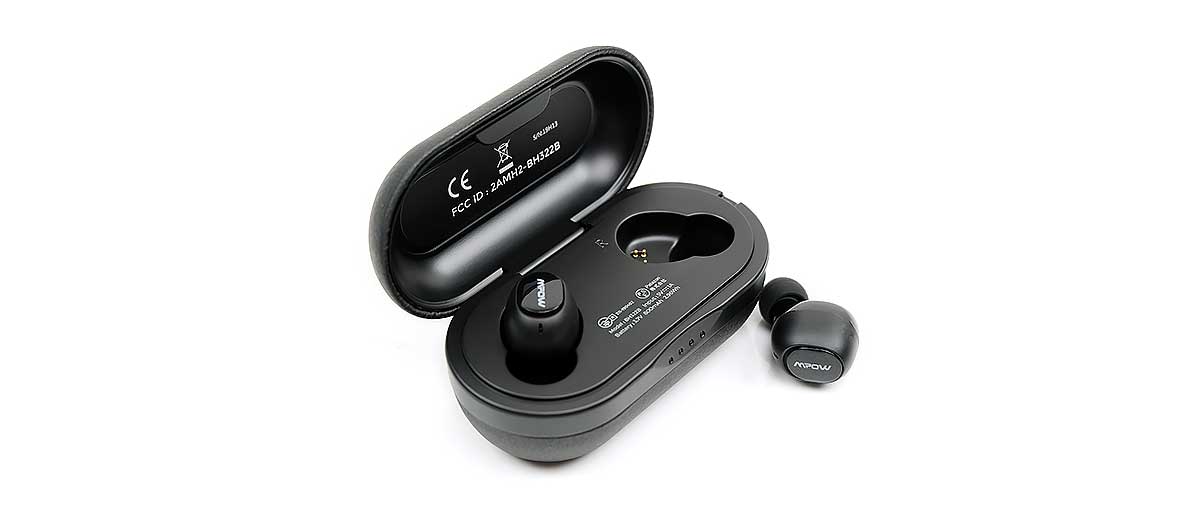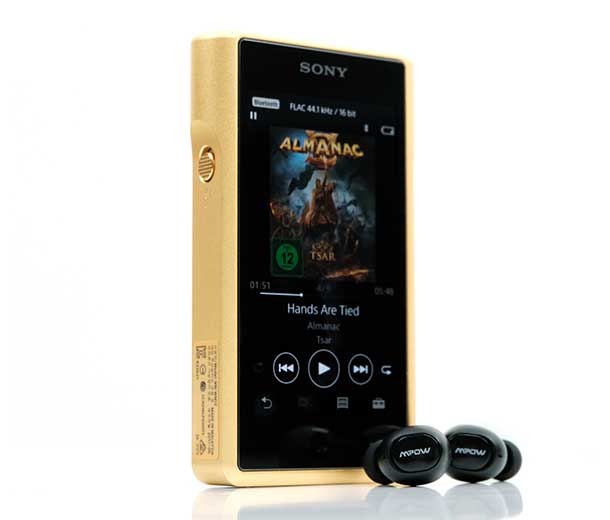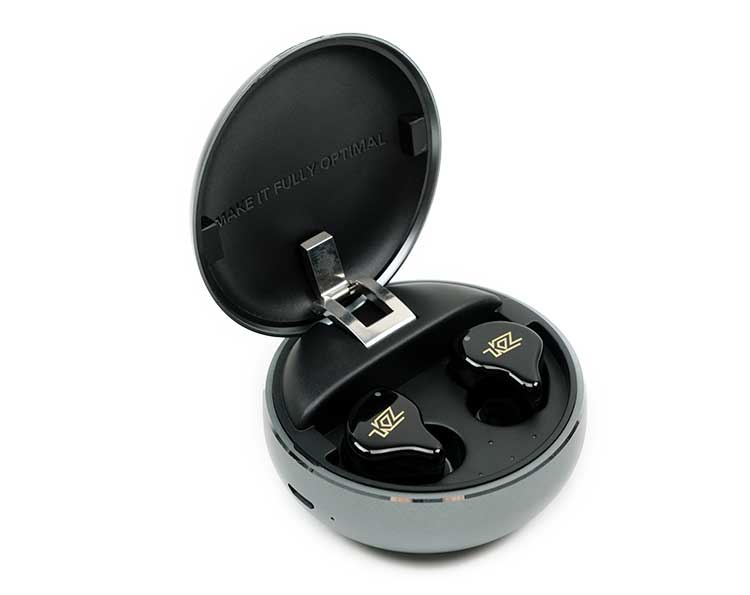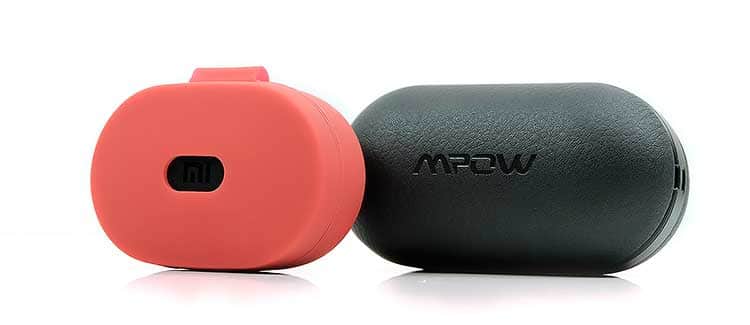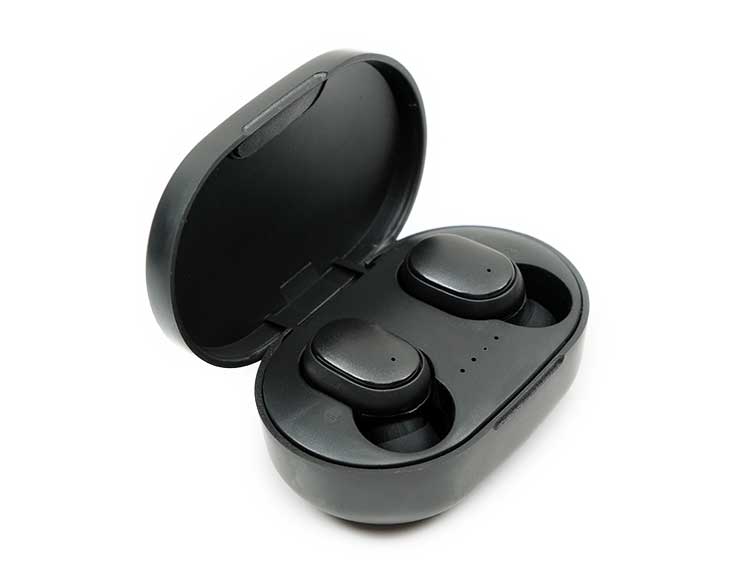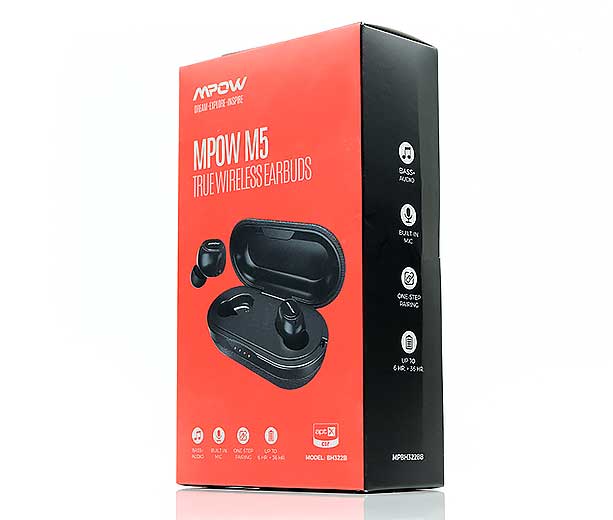Sound Impressions
Summary
The MPOW M5 delivers a V-shaped response curve with a vibrant sub-bass emphasis and slow steady dip down to around 800Hz to 1K. Thereafter, it has a mid to upper mids elevation pushing vocals forward, especially female vocals. Treble is relatively coherent with just a slight peak around 6-7k. There is not a post 5k roll-off robbing it of air quite like the KZ T1 treble performance.
This is in the same ballpark as the Airdots in terms of FR emphasis but at a much higher performance level. The key difference for me is that aptX dynamic range and simply using a better driver. The MPOW M5 sounds much more open and engaging with a more refined harmonic balance.
The bass is strong but like most dynamic drivers it is a bit slow-paced with a longish decay. Great stuff for synth wave, EDM and modern R’n’B but not the best or the most revealing for midrange rock genres.
Timbre
The M5 timbre is actually more accurate for my tastes than the KZ T1. There is less of that fluffy mid-bass warmth allowing instruments to show a bit more clarity and bite, no doubt helped by the aptX codec quality and what I consider to be a grander, airier soundstage allowing everything to breathe a bit easier.
There is a slightly liquid treble overtone that also prevents the presentation from being all contrast and no texture also which I tend to prefer if I am going to use a V-shaped colored monitor.
Staging
You should not be surprised when I describe the M5 staging has having good depth, a narrow lower midrange, forward vocals, and a neutral treble. Height is also good and much better than the KZ T1. As a result, the M5 is the airiest and grandest of the TWS drivers I have reviewed to date.
Yet it is not aloof nor detached. Vocals are forward, especially female vocals which stretch the staging front to back and enhances the engagement to a certain degree. Male vocals struggle a bit more with the bass power sometimes dominating.
Genre Preferences
This is an out and out modern dance/R’n’B, EDM, and synth-wave TWS monster. It paints a grand stage with enough vocal intimacy to carry female vocals over simple mixes. It driver home fat bass synth layers and double-kick drums but rhythm guitars sound anemic and lacking in body. Get the KZ T1 if you want a warmer midrange performance and a little more BA pace. The M5 is a colder powerful sounding budget TWS.
Wireless Performance
Pairing
This was a really easy TWS to pair with except for Lotoo’s PAW Gold Touch DAP. To be fair, pretty much all of the TWS tested thus far have stability issues with the PAW Touch Gold. For some reason, it drops the pairing. Both smartphones tested, a Note 9 and P20, had rock-solid connections and fast pairing.
Taking the M5 out of the cradle will automatically power them on and go into pairing mode. You get that female voice from the drivers advising you what is happening throughout and none of the KZ T1 left-right pairing nonsense that forced me to reset before I had begun. As an FYI if you do see left and right MPOW M5 in your pairing search, choose the right. Left will give you mono mode only.
Stability
Once paired, and if compatible the M5 will deliver aptX on a best effort basis. I did not have to resort to dropping down for connection stability (SBC) once with both left/right and source connections rock solid. The distance was slightly better than the Airdots by a few feet and better than the KZ T1 also.
Smartphone performance was better than DAP performance except for the Sony 1Z. With the PAW Touch, it was just unworkable. With the Cayin N6ii, it was more stable but the distance was not as good as the two smartphones by a few meters. The HiBy R5 was equally weak as a source for the MPOW M5 with a breakup long before we got to the smartphone distance of about 15 meters, (the end of my house). The 1Z proved to be the most stable with the MPOW M5 of the 3-4 tested.
Latency
Despite having aptX, there is no inclusion of aptX LL with the MPOW M5 so you will notice some delays in voice sync in movies though the amount of delay is variable. For low-quality stuff on YouTube, it is less noticeable but with VLC and a 1080p 768Kbps audio bitrate MKV file, there was a 0.2-second delay. Enough for me to reach for the audio sync command option.
Comparison Ladder
Since this is our third review and technically our fourth TWS covered we will start moving the comparisons around a little to constitute our ladder from the best to the worst. Comparisons will also be briefer the longer it gets.
Once we hit 6, we will revert to a select 3 comparisons per review and hotlink to a “Best of TWS” page which will be ranked by the editorial score.
KZ T1
$42
Technical
The KZ T1 on paper seems a touch more ambitious and more audiophile orientated with a hybrid dual dynamic and BA driver configuration. They are also $8 cheaper than the M5 with a driver design that uses custom universal contouring for a nicer fit than the M5. The KZ T1 also uses touch controls which I much prefer over the M5 push-button control system as it can push the tips uncomfortably down your ear canal.
On the flip side, the M5 is IPX7 rated whereas the KZ T1 has no rating at all. The M5 is the better choice for gym and outdoors whereas the KZ might just short circuit on you with enough moisture.
The M5 battery life is much better for both driver and case. You get 5-6 hours and 35 hours for the M5 compared to just 3 hours for the KZ T1 drivers and 21 hours for the case. You will find that the T1’s are in the case quite a lot. Both have micro-USB for charging so neither case is the fastest to top up.
Both have independent left-right bud control, BT5.0, zero app integration and seal roughly the same on the stock tips for me on a personal level. I just find the KZ T1 the more comfortable of the two in the ear given its better audiophile heritage in the design.
Performance
The pairing process for the KZ T1 is tiresome and bordering on broken. It is very hard to pair with new sources without having to reset the entire system and place it back in the cradle for a few seconds. The M5 is seamless by comparison and pairs with no issues at all. Both have a good level of distance though the stability of the KZ is a bit shakier overall with a bit more left/right disruption.
I also had more problems with the volume control of the KZ T1 compared to the M5. The jumps on both my smartphones were much too big whereas the M5 felt a bit steadier and smoother,
Tuning
Tuning wise the KZ T1 is warmer with less sub-bass power but better lower-mids presence and a slightly clearer male vocal delivery. The M5 has a more pronounced V-shaped dip but with plenty of depth and impact. It lacks the body of the KZ T1 for anything that straddles around 500Hz to 1k but compensates with a very strong bass fundamental.
My big problem with the KZ T1 though is the lack of treble air when compared to the M5. Whilst the BA driver does a really nice job in terms of midrange pace the M5 is the airier and more spacious of the two. Combined that with the better aptX dynamic range and it becomes the believable sounding of the two for vocal timbre.
The rest is down to preference in the tuning emphasis. The enhanced bass, cooler timber of the narrower mids and the cleaner airier treble of the M5 or the warmer mid-bass and midrange of the T1. the KZ T1 is a big step up on the Airdots but I think the M5 is slightly more rewarding at this price point.
Xiaomi Redmi Airdots TWS
$29.99
Technical
The Airdots are a 7.2mm single dynamic driver TWS and are smaller in size for both the drivers and charging case compared to the M5. As of now, they are the smallest we have reviewed to date. We suspect the M5 is using a larger dynamic driver or at least a better implementation and acoustic chamber.
The finishing and design of the drivers and case are plainer and cheaper looking than the M5. The M5 is no looker either but the branding on the front and lossy plate combined with the faux leather finish on the curved charging case make a better pitch. The M5 case seems more durable also and getting the drivers in and out of the case is much easier than the fiddly Airdots.
Both offer BT5, independent driver use, physical controls, a level of DSP noise reduction and elemental resistance. However, the MPOW M5 has better decoding capability with aptX as well as a higher IPX7 rating compared to the Airdots IPX4.
The MPOW M5 buries the Airdots for battery life from both the buds and the charging case at 5-6 hours compared to 4 and up to 35 hours for the case compared to just 12 for the Airdots. No contest on which one has more longevity. Both charge using micro-USB which is meh.
One cute thing, however, is the Airdots quasi-app integration with the DotDroid app for battery and audio life. I do with MPOW had something similar.
Performance
In terms of stability and distance both performed equally as well with the given space I had within the house. That’s about 10-15 meters and a single partition between the drivers and source. Neither could cope with the second wall at the 15m marker.
Both TWS had problems with stability with some of my DAPs such as the Lotoo PAW Gold Touch which kept dropping the connection. The HiBy R5 and iBasso’s DX160 both cut out before both of my tested smartphones on both TWS.
Tuning
Bear in mind the Airdots are just SBC and not aptX so the M5 is already at an advantage with equal distance and significantly better dynamic range with a higher codec. And boy does it that show in sound quality.
The M5 has a far better level of instrumental separation, resolution and a more agreeable harmonic balance. Despite their obvious coloration towards the low-end, the M5 has a more accurate harmonic balance compared to the Airdots.
Vocals are further forward and with more presence on the M5. They also convey slightly better texture and detail than the Airdots midrange. The Airdots struggles to project adequate body beyond the bass in comparison. They have a thinner-sounding lower-midrange and a slightly metallic treble overtone.
By contrast, the M5 is more rounded with the better body in both male and female vocals. It also sounds smoother and more liquid in its treble delivery. Percussion has weight and texture rather than a brittle thin type sound that the Airdots tends to produce.
As for bass, well no question the M5 hits harder and deeper. There is far more power in the M5 dynamic driver, better sub-bass extension and unquestionably more detail. It really helps the M5 convey a better level of PRaT compared to the Airdots, especially for EDM and R’n’B. That also means better staging depth on the M5 and an altogether more immersive presentation.
A6S TWS
$8-9
Honestly, I cannot foresee the A6S TWS coming off the bottom of the comparison ladder for a very long time. This is tinny, compressed, unstable and as sharp sounding as my grandmother’s wit. The M5 kills it on every level including audio quality, Bluetooth stability or performance, as well as voice clarity.
Its sole purpose is to remind you that cheaper OEMs can and often do sound like a raging shiny turd. Do you get what you pay for? If audible revenge on a relative is on your list then yes. Otherwise, spend the money on a slice of some nice cheesecake and enjoy your evening.
Our Verdict
The MPOW M5 is our third, (we do not really count the A6S), TWS reviewed to date. I believe it just edges ahead of the KZ t1 for sound quality but some of that will be a preference based as mentioned above.
You can make an argument for both but my own preference is for the M5 slightly cooler tone and grander soundstage. I also love the bass quantity the M5 can produce and it is the most powerful sounding of the 3 TWS I have heard to date in detail.
Pairing, stability, and distance I have no issues with on the M5. It is a lot simpler to pair than the KZ T1 that’s for sure. Still looks like a blobby black jellybean though so not much brownie points for styling. The KZ T1 still has the design audiophile credentials.
Still, for $49.99 I take the better stability, IPX7 and aptX ceiling of the M5 over the KZ T1’s cool looks any day of the week. The T1’s reign at the top of our TWS arc was very short-lived.
MPOW M5 Specifications
- Connection: Bluetooth 5.0 with AptX
- Qualcomm 3020 chipset
- Battery Life: 5-6 of playback
- Charging case: Can charge earpieces fully 7 times
- Charging case capacity: 280mA
- Up to 35H Play Time (charging case), 2 hours charging
- Stand-by Time (Connection status): 92 hours(L); 110 hours(R)
- Waterproof Rating: IPX7
- CVC 8.0 Noise Reduction
- Dual Microphones Installed
- iOS battery capacity display
- SIRI support
- Wireless up to 33Ft
- Speaker frequency response: 20Hz-20KHz

